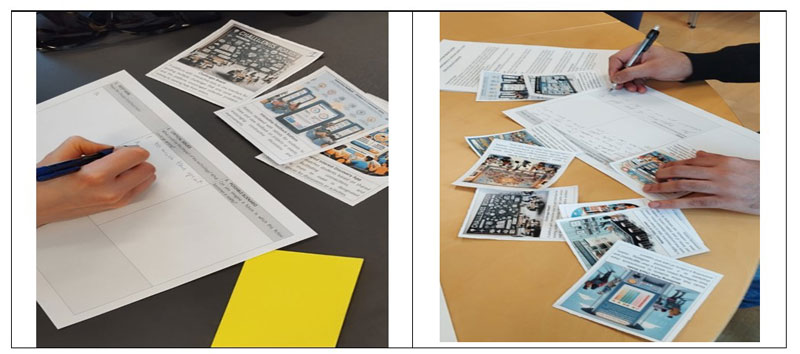by Gul Sher Ali and Sobah Abbas Petersen (Norwegian University of Science and Technology, Norway)
Early-stage doctoral students are often vulnerable to feelings of isolation. This research explored the integration of Information and Communication Technologies (ICT) for enhancing social sustainability. The findings of a case study demonstrated how technology-based social infrastructures within academic communal spaces could mitigate isolation among students by fostering community engagement. The research is done as part of the SWELL project (at NTNU, Norway) which aims for sustainable health and wellbeing in the built environments through innovative solutions.
The rising mental health issues among students pose a significant challenge for the higher education sector [1]. The wellbeing of doctoral students is particularly affected by various stressors, but the lack of social connectedness due to the solitary nature of their work is a substantial factor. Social connectedness encompasses the feeling of forming close bonds with individuals or groups. It is a multi-dimensional concept that includes the sense of community belonging, social appraisal (how one interprets others’ behaviours), and relationship salience (the experience of connectedness despite physical absence) [2]. These are also common issues that research on sustainable communities and urban spaces addresses. Therefore, this research offers valuable insights into how technology could be integrated into communal spaces to supplement existing social practices such as socialising and sharing. The research expands the social connectedness framework (see Figure 1) by incorporating communal technologies into academic settings. This integration not only improves social connectedness, but also aligns with educational sustainability by facilitating continuous learning and interaction among students, which is crucial for fostering informed, engaged, and resilient urban communities. Additionally, the study highlights the importance of addressing privacy concerns and finding a balance between digital and physical interactions.
![Figure 1: Enriched social connectedness framework, adopted from [2].](/images/stories/EN138/ali1.png)
Figure 1: Enriched social connectedness framework, adopted from [2].
This case study is conducted as a part of the SWELL project [L1]. The project aims at studying health and wellbeing in the built environment, with a specific focus on the transformative role of ICT in fostering community and enhancing social sustainability. The objective is to understand how ICT can foster behavioural changes conducive to social sustainability in the built environment and to design ICT artefacts that support such behaviour change. The findings of this study provide insights for urban policymakers and technology developers interested in creating sustainable, inclusive, and supportive urban environments.
In this case study, we conducted semi-structured interviews with seven early-stage international doctoral students (at NTNU, Norway). These individuals were selected as they were in a transitional phase that impacts their social connectedness. The interviews were complemented using brochures of questionable concepts [3] depicting fictional technologies. The questionable concepts were designed to provoke thought and discussion about possible ICT implementations in communal spaces. These speculative technological concepts (see Figures 2 and 3) aimed at fostering each dimension of social connectedness – belongingness, social appraisal, and relationship salience. For instance: communal digital noticeboards for sharing academic achievements and personal milestones, interactive mosaic screens that display ongoing community activities, and mobile apps designed to celebrate personal and communal achievements. Such technologies are envisioned to create a lively and interactive communal space that encourages students to engage more deeply with their academic community.

Figure 2: Brochures of questionable concepts (the images created by Dall-E based on given description).

Figure 3: Interview session and worksheet instrument used to gather data.
The analysis revealed significant insights on the integration of ICT that could transform communal spaces into hubs of social activity. The students expressed a strong preference for technologies that facilitate real-time social interactions over those that offer only digital communication. For instance, one student highlighted the potential of a communal mosaic screen to not only display information but also to invite others to meet in person based on shared interests. Technologies that provide a balance between digital interaction and personal privacy were particularly favoured by the students. The achievement celebration app, which allows students to opt in or out depending on their comfort with public accolades, was noted for its ability to foster a sense of community while respecting individual privacy preferences. The visibility of shared interests and the recognition of individual and group achievements through communal technologies plays a crucial role in turning solitary routines into collaborative and interactive experiences. These interactions are not only vital for social wellbeing but also for academic success, as they provide platforms for feedback, collaboration, and professional growth. Additionally, employing ICT in this manner showcases a practical application of urban data analytics and enhanced our understanding of digital infrastructure that can support sustainable cities.
A recurring theme throughout the interviews was the concern over privacy. The design of communal technologies, therefore, must prioritise privacy to prevent potential overexposure that could deter their use. Moreover, while digital technologies are beneficial, our findings emphasise the importance of their role in facilitating rather than replacing face-to-face interactions. The technology should be seen as a bridge to physical community building rather than diminishing the richness of direct social interactions. This research provides valuable inputs to develop a roadmap for educational and urban policymakers and technology developers looking to enhance communal spaces with ICT, ultimately contributing to the social sustainability within smart urban environments.
Link:
[L1] https://www.ntnu.edu/sustainability/swell
References:
[1] P. C. Jackman et al., “Mental health and psychological wellbeing in the early stages of doctoral study: a systematic review,” European Journal of Higher Education, vol. 12, no. 3, 293–313, 2022.
[2] S. Vuningoma et al., “How refugees in South Africa use mobile phones for social connectedness,” in C&T ’21, Jun. 2021, 128–137.
[3] L. Thomas et al., “Exploring digital support for the student transition to university through questionable concepts,” Pers Ubiquit Comput, vol. 26, no. 1, 79–92, 2022.
Please contact:
Gul Sher Ali and Sobah Abbas Petersen, NTNU, Norway











